Dog Impulse Control: How to Achieve it
- Anja Boecker
- Updated: 2023-08-22
When a dog is out of control, it can be very stressful for you as a dog owner. Nerves are frayed because your dog may run into the street, bicycles, or strangers at any time. Impulse control in dogs is the key to a balanced and harmonious human-animal relationship.
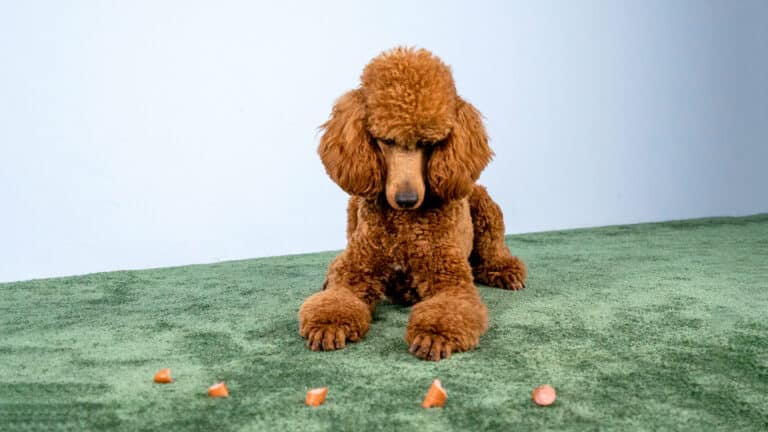
What Is Impulse Control?
Impulse control means that your dog is able to control his instincts and impulses to remain calm and obedient, even when he is excited or something catches his attention.
This can help him make better decisions and behave appropriately in different situations.
Impulse control is the ability to control and direct your dog. He learns to control himself. It takes work, patience and effort. But it pays off.
When Should I Start Practicing?
Impulse control can be taught in puppyhood by teaching the dog to respond to signals such as "sit" or "wait" and to control his impulses. The earlier this is started, the easier it will be for the dog to master this skill throughout his life.
Difference in Impulse Control and Frustration Tolerance
Impulse control in dogs means that they can restrain their spontaneous reactions. Imagine your dog sees a tasty piece of meat, but doesn't immediately jump at it - that's impulse control.
Frustration tolerance in dogs describes how well they handle situations where they don't get what they want. If your dog stays calm when he doesn't get his ball right away, he's showing good frustration tolerance.
Basically, impulse control is about controlling behavior, while frustration tolerance is about how well the dog can handle disappointment.
It is important to train both skills in order to have a happy and balanced dog.
Benefits of Good Impulse Control
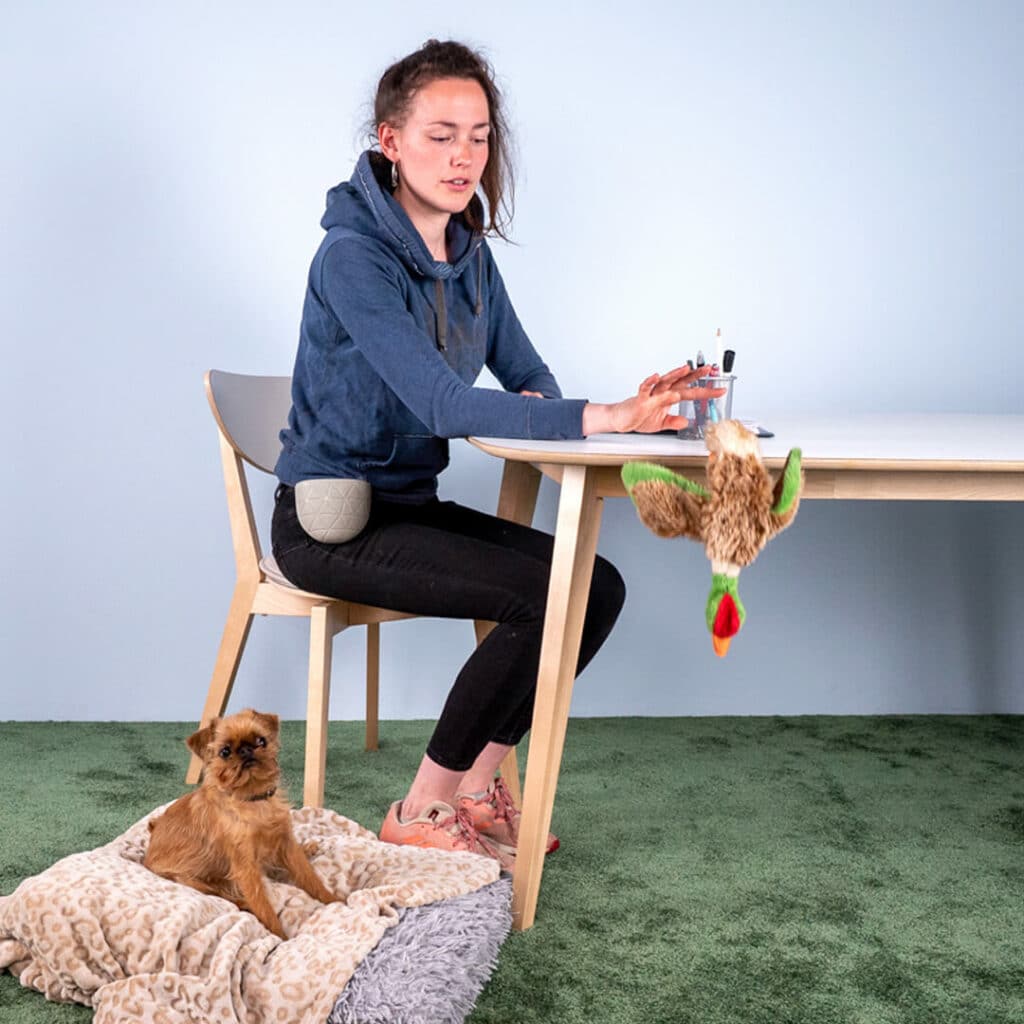
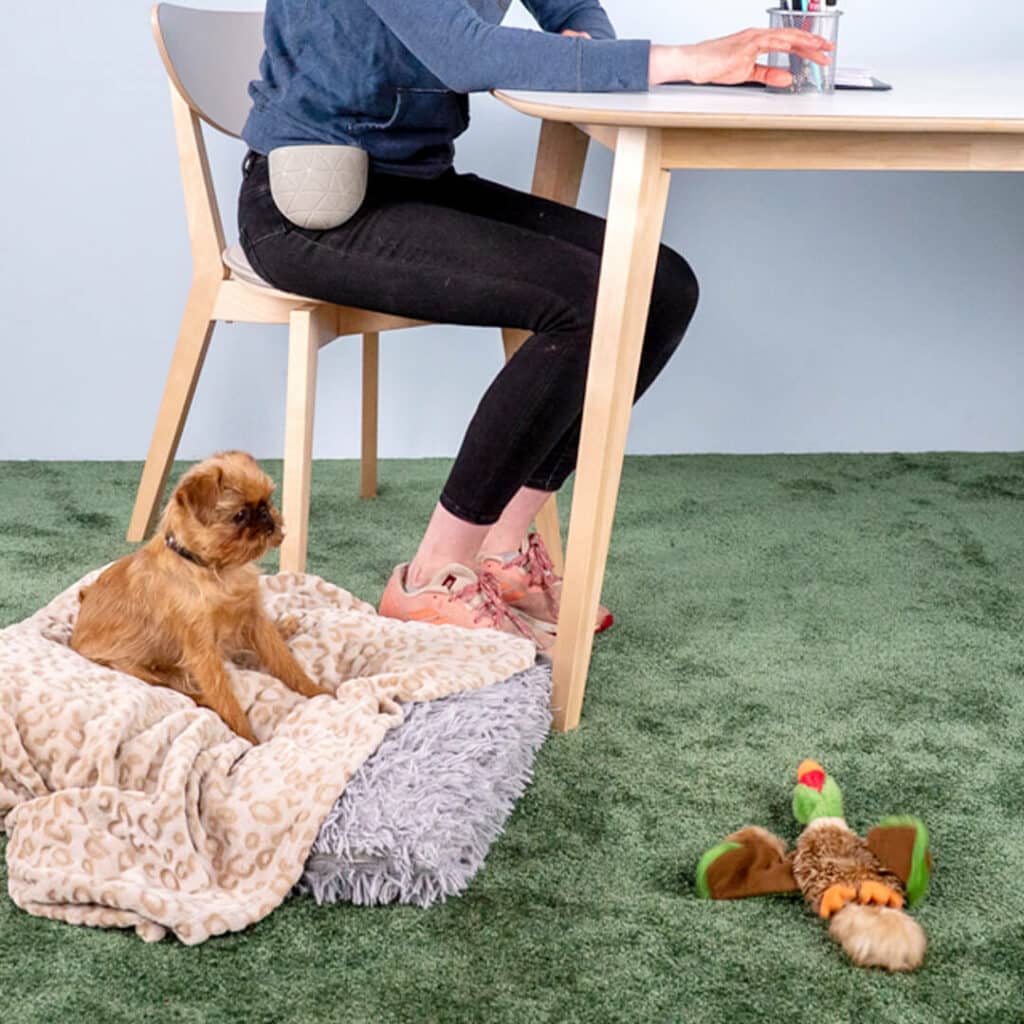
The benefits of impulse control are clear. You're teaching your protégé to control himself. That alone is a huge benefit. But there are other benefits for your dog:
- Appropriate Behavior: Dogs with good impulse control are more responsive and have fewer problem behaviors. They do not jump on people, jump on their food, or run wild when excited.
- Safety: Impulse control can make your dog safer. For example, it can prevent your dog from running into the street to chase a ball.
- More Effective Training: Impulse control is an important foundation for training. A dog that has learned to control his impulses will learn new commands more easily and respond better to training.
- Happier Dog: Good impulse control ultimately results in a happier dog. A dog that has learned to control his impulses is better able to handle stress and frustration and is more comfortable in his environment.
- Dog Meeting: Impulse control ensures that your dog does not immediately go after every other dog. He stays calmer and less stressed when he meets other dogs. Your dog learns that it's OK to meet other dogs without immediately greeting them. This is also safer for other dogs. Not every dog likes to be approached by another dog. A dog with good impulse control is less likely to bother others and avoid conflict. This is better for the dog's overall well-being.
Another advantage: you can control their behavior on the leash influence positively. Your four-legged friend will no longer tug uncontrollably on the leash and your walks will be more relaxed.
Impulse Control Training
Impulse Control builds on the rules your dog already knows.
Take the command "sit" for example. This is the best initial training for you and your pet.
Does your faithful companion not yet know this command? Then your dog should learn it as soon as possible. Only then can you proceed with impulse control.
Here is a short and promising guide for you:
"Learn to "Sit!
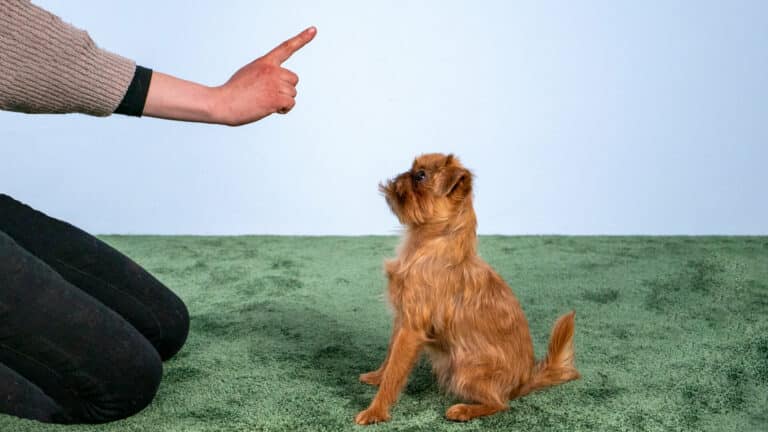
1) Get Your Dog to Stand Up
The first thing you want your dog to do with this command is to assume a standing position. This is important to show the change that should occur during this exercise.
2) Reward at Hand
After your dog assumes the standing position, pick up a treat. This should be done as unobtrusively as possible. Then you can direct your dog's attention to your hand and the treat.
Now that your puppy is focused on the snack, move your hand over his head. You'll notice that they'll sit down shortly after.
3) Give Your Dog Rewards
When your pet assumes the sitting position, you can give him the treat. Show him other rewards as well. Pet him and reward him with words like "Good job" or "Good(er) (dog's name)".
4) Apply a Command
After you have performed step 3 a few times, you can proceed to step 4.
The fourth step is to watch your dog carefully. Before you move the hand with the treat over your dog's head, step in and say the word "sit. Your dog will associate this command with your behavior.
5) Grind & Repeat
Repeat this step several times a day for a few days. Sooner or later, your dog will master the sit command.
Voila! Your Dog Has Learned the “Sit” Command
Awesome! You've successfully taught your furry friend to sit. Now you can return to the topic of impulse control. The sit command is the best way to build impulse control.
So far, your trainee may not be able to control himself long enough to stay in the sitting position. He may be able to hold it for a few seconds before getting restless. That's where impulse control comes in.
For example, impulse control allows you to keep your dog sitting for longer periods of time. Now he has internalized it for sitting and can apply this control to other behaviors.
The idea is to improve your dog's patience step by step. In the beginning, a little back and forth is enough. Then give him the treat. After that, you will begin to incorporate more and more stimuli into your dog's training.
The goal is to eventually get you to leave the room for a few seconds. When you come back in, you can give your dog the treat and pet him a little.
Of course, you leave the room only after intensive practice. If you use this stimulus too early, your protégé is likely to be overwhelmed.
Training has a counterproductive effect on his behavior. Therefore, it is important that you include enough intermediate steps.
These intermediate steps may be:
- You sit down for a moment and get up right away.
- You run to the closet or dresser looking for "something"
- Passing the treat from one hand to the other
- You ignore your dog for a few seconds and look around the room
- You put out treats that your dog doesn't get right away yet
- You drop a toy
There are other intermediate steps to improve your dog's impulse control. There are no limits to your creativity. Ideally, you want to make sure that the intermediate steps are not too far apart in difficulty.
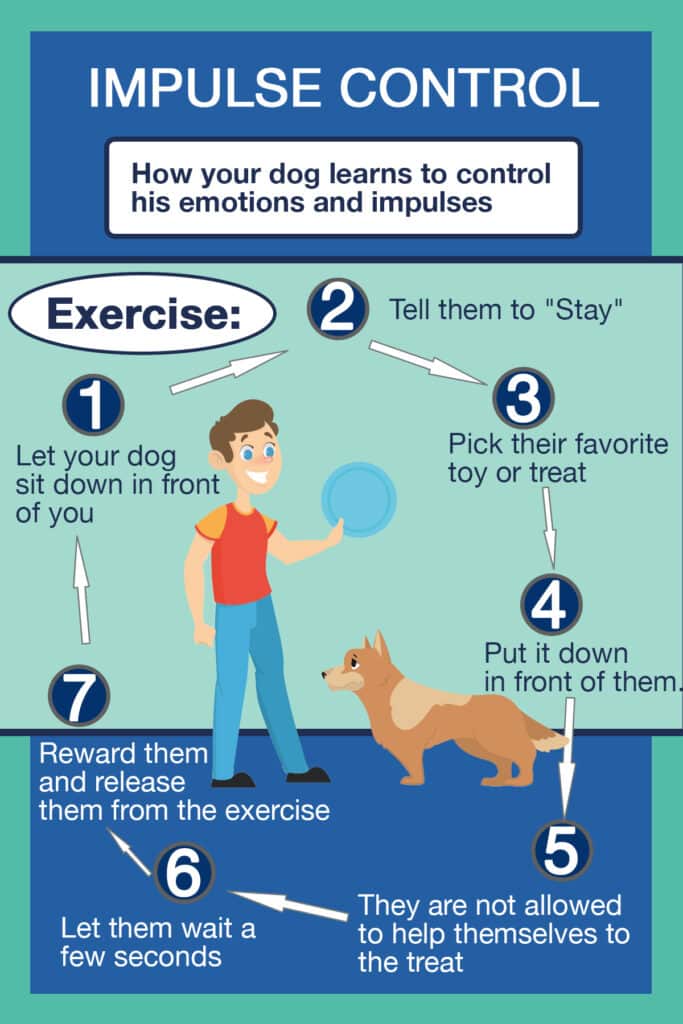
5 Impulse Control Exercises
There are many different exercises you can do with your dog to improve his impulse control. Here are 5 of them:
"Stay Exercise": This simple exercise consists of asking your dog to stay in one place while you walk away. Start with short distances and slowly increase the distance and time if your dog successfully stays.
“Wait for Food”: Before giving your dog his food, have him sit or lie down and wait until you give him the command to start eating. This will help him learn to control his impulses, even when he is very excited or hungry.
"Door Exercise": Have your dog sit and wait until you open the door and allow him to go through. This will teach him that he doesn't have to run through the door as soon as it opens.
"Toy Exercise": Throw a toy or ball, but don't let your dog run after it. Give him the command to wait until you allow him to retrieve the toy.
"Treat Exercise": Hold a treat in your closed hand and make your dog wait until you give him the command that he can have it.
These exercises should always be done with lots of patience and positive reinforcement. Every dog learns at his own pace, so be patient and consistent. Over time, your dog will be able to better control his impulses, resulting in a happier and more balanced dog.
The Rules Behind Dog Impulse Control
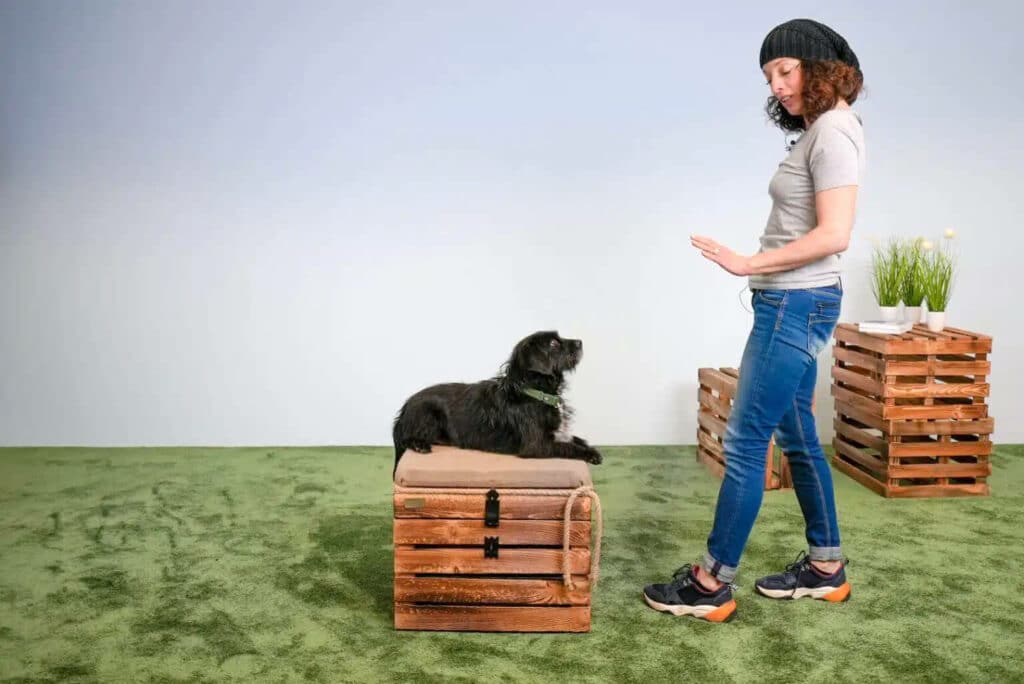
Have you been able to internalize your dog's impulse control and continue to improve it? Then you have almost reached the end of this topic.
We have put together some useful tips and tricks for you. These will help you in your active training.
1) Reward Even the Smallest Achievements
Do not wait too long with rewards. They should be used for small feelings of success.
Prior to the actual impulse control training and the first training trials, reward each small sense of success. The rewards can be in the form of treats or petting.
2) Be Consistent
Impulse control training should be used in everyday life. This is important so that the dog learns to remain calm in all situations.
Ideal "daily habits" can be:
- Feeding
- Walking With the Leash (Letting Go of the Leash, Picking up the Leash)
- Opening the Front Door
- Meet Other Dogs or Friends
- Before a Reward
- When Opening the Balcony, Car or Patio Door
3) Don’t Make Training Stressful!
It is highly recommended that the training and exercises be completely stress-free.
For this reason, it should be understood in advance that training requires patience and time. Stress or impatience can be counterproductive to success.
4) Never Blame or Punish
Punishment and aggressive behavior are also counterproductive to training success. Such actions must be avoided at all costs.
Aggressive behavior or punishment in the form of verbal, emotional, or physical abuse should never be used in dog training.
Frequently Asked Questions
With impulse control, the dog should learn to control himself and not run around uncontrollably or jump on strangers. Impulse control extends to all situations in the dog's daily life.
With enough patience and training, any dog can learn to control his impulses. The sooner training is started, the sooner the dog will have successful impulse control training.
The easiest way to do this is to have the dog sit first and then let it sit. Once the dog learns to stay seated despite other stimuli, you can transfer this impulse control to other situations. Read the full article for more information.
Especially with very excited dogs, there are many stressful situations in everyday life: Leashing, dog and human encounters, traffic. With impulse control, your dog will be less likely to act out and situations will be more relaxed.
Always try to create a stress-free atmosphere and praise your dog for every small success. Be very patient and take small training steps at a time so as not to overwhelm your dog.
My Conclusion
Impulse control can make living with your four-legged friend much easier. Many dog owners use impulse control and have already achieved great success.
With impulse control, you can better control your dog. This will benefit him and also your environment.
Follow our instructions, tips and tricks. This way you will quickly achieve success. If you want to know more, check out our App on and join in on the impulse control.

My name is Anja Boecker, and I am a certified dog trainer and behavior consultant. With these articles, I want to help you to understand your dog better and to build an inseparable bond.
Share Now:


That sounds really great, but how exactly do I practice impulse control so that the dog also stays put (even for a few seconds)? My puppy likes to be active, the sit works fine but the "stay", i.e. stay put, does not work, he always runs after me (which is not necessarily bad) and therefore does not learn the command. Do you have a tip for me? Thank you!
Dear Annemarie, unfortunately there is no exact instruction that works immediately with every dog. It is best if you internalize that the training should be built up with a lot of patience. It is best to approach the matter step by step. If he already masters the "sit" exercise, then you can increase the time he should stay in this position without moving yourself. After that, incorporate very slight movements, e.g. a daring step to the left or to the right or backwards. Keep practicing this until you notice that your movements are not getting him to come out of the "sit" position. Reward him with a treat. Gradually, you can start trying to get out of the room. Good luck 🙂 .
Hello how do I practice impulse control when encountering other dogs.My 2 year old dog (mini Aussie) then does not respond to treats or a toy. She barks and pulls like crazy on the leash, and really just wants to play.
Dear Monique, in extreme cases it is always advisable to call in an expert on site (e.g. behavior therapist, trainer). This would ensure that this professional can observe your dog for a while to find out what the reason is, after which a strategy will be developed and the behavior pattern of your dog will be changed accordingly. We wish you much success!
Dear Monique, your dog is probably overwhelmed with the situation and does not focus on you. You can first start to make the situation easier and ask friends, with already known dogs, to practice with you. Direct the attention there to you.
But, it is a very complex issue. I would also advise you to contact a dog trainer. These behaviors usually don't stop on their own - even when the dog gets older. Most of the time they become more established. That's where on-the-spot help is really important. Good luck with your training!